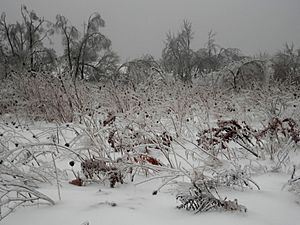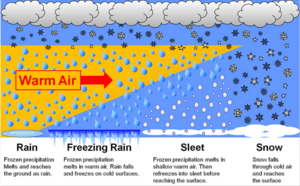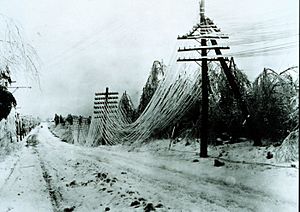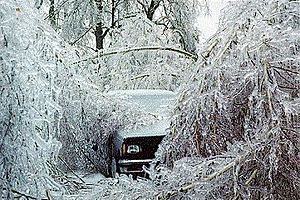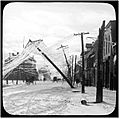Ice storm facts for kids
Ice storms are a type of weather that happens because of freezing rain. When this rain hits cold surfaces, it quickly turns into a thin layer of ice. Ice storms can cause many problems. They can lead to accidents, knock down power lines, and cause a lot of damage.
In the United States, a storm is called an ice storm if at least 0.25-inch (6.4 mm) of ice builds up on things outside. Between 1982 and 1994, ice storms happened more often than blizzards. There were about 16 ice storms each year. These storms usually feel like a gentle rain, even though the temperature is just below freezing.
How Ice Storms Form
Ice storms start when there is a layer of warmer air high up. Below this, there is a layer of very cold air near the ground. Frozen rain or snow melts as it falls through the warm air. Then, it starts to refreeze when it enters the cold air closer to the ground.
- If the rain refreezes completely while still in the air, it will fall as sleet. Sleet is like tiny ice pellets.
- Sometimes, the rain droplets do not freeze in the air. They stay liquid even when they pass through the cold air near the ground. This happens because the air cools the rain to a temperature below freezing (0 °C or 32 °F), but the drops themselves do not turn into ice. This amazing phenomenon is called supercooling.
When these supercooled drops hit something cold, like the ground, power lines, or tree branches, they instantly freeze. This builds up a layer of ice, which is why we call it "freezing rain."
What Happens During an Ice Storm
Freezing rain from an ice storm covers everything with a heavy, smooth layer of ice. This makes driving and walking very dangerous. The weight of the ice can also break branches or even entire trees.
When branches fall, they can block roads. They can also tear down power and telephone lines. Even without falling trees, the ice itself is very heavy. It can easily snap power lines and even break strong utility poles. Sometimes, even large electricity pylons with steel frames can be damaged.
This damage can leave people without electricity for days or even a month. Experts say that just a quarter of an inch of ice can add about 500 pounds (230 kg) of weight to each section of a power line. Ice storms can cause so much damage that they can shut down entire cities.
Images for kids
-
A close-up of a pinecone covered in ice.
See also
 In Spanish: Tormenta helada para niños
In Spanish: Tormenta helada para niños


